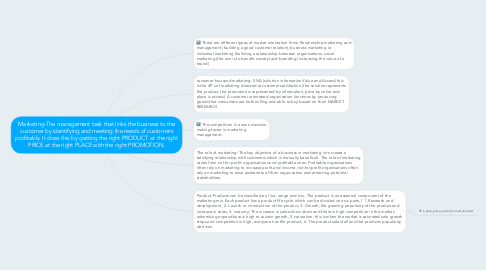Marketing-The management task that links the business to the customer by identifying and meeting the needs of customers profitably. It does this by getting the right PRODUCT at the right PRICE at the right PLACE with the right PROMOTION.
by Laurence McKenzie-phillips

1. There are different types of market orientation firms: Relationship marketing and management (building a good customer relation), business marketing or industrial marketing (building a relationship between organisations, social marketing (the aim is to benefit society) and branding (increasing the value of a brand)
2. customer focussed marketing: SIVA (solution information Value and Access) this is the 4P's of marketing directed at customer satisfaction (the solution represents the product, the promotion is represented by information, price by value and place is access). A customer orientated organisation functions by producing goods that consumers are both willing and able to buy based on their MARKET RESEARCH
3. The competition is a main decision making factor in marketing management.
4. The role of marketing: The key objective of a business in marketing is to create a satisfying relationship with customers which is mutually beneficial. The role of marketing varies from not for profit organisations and profitable ones. Profitable organisations often rely on marketing to increase profit and income, not-for-profit organisations often rely on marketing to raise awareness of their organisation and attracting potential stakeholders.
5. Product: Products can be classified as; line, range and mix. The product is an essential component of the marketing mix. Each product has a product life cycle which can be divided into six parts, ( 1. Research and development, 2. Launch or introduction of the product, 3. Growth; the growing popularity of the product and increase in sales, 4. maturity; The increase in sales slows down and there is high competition in the market, advertising expenditure is high to sustain growth, 5. saturation: this is when the market is saturated sale growth stops and competition is high, everyone has the product, 6. The product sales fall and the products popularity declines.
5.1. 4P's: price, place, promotion and prooduct



